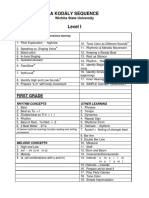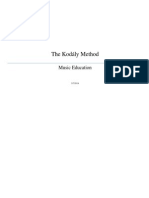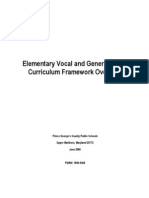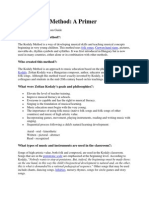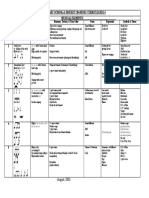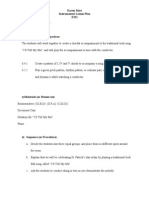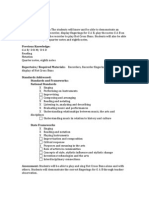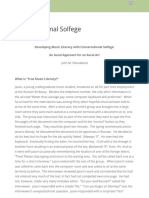Kodaly
Kodaly
Uploaded by
Kasmini SohCopyright:
Available Formats
Kodaly
Kodaly
Uploaded by
Kasmini SohOriginal Description:
Original Title
Copyright
Available Formats
Share this document
Did you find this document useful?
Is this content inappropriate?
Copyright:
Available Formats
Kodaly
Kodaly
Uploaded by
Kasmini SohCopyright:
Available Formats
What is the Kodaly Method?
Zoltan Kodaly (1882-1967) The Kodaly Method is a way of developing musical skills and teaching musical concepts beginning in very young children. This method uses folk songs, Curwen hand signs, pictures, movable doh, rhythm symbols and syllables. It was first introduced in Hungary but is now used in many countries, either alone or in combination with other methods. Who created this method? The Kodaly Method is an approach to music education based on the philosophies of Zoltan Kodaly. Zoltan Kodaly was a Hungarian composer, author, educator and expert on Hungarian folk songs. Although this method wasn't exactly invented by Kodaly, it was developed by his colleagues and students in the mid-20th century based on his teachings. What were Zoltan Kodaly's goals and philosophies?
Elevate the level of teacher training. Improve musical literacy in schools. Everyone is capable and has the right to musical literacy. Singing is the foundation of musical learning. Music education must begin with the very young. The importance of using folk music (native folk songs and folk songs of other countries) and music of high artistic value. Incorporating games, movement, playing instruments, reading and writing music with singing. Sequential process following a child's natural learning development: Aural - oral - kinesthetic Written - pictorial - abstract Read - recognised
What types of music and instruments are used in the classroom? Songs of high artistic value, both folk and composed, are used in the Kodaly classroom. Songs that are in the pentatonic scale are emphasized at the beginning level. According to Kodaly, "Nobody wants to stop at pentatony. But, indeed, the beginnings must be made there; on the one hand, in this way the child's biogenetical development is natural and, on the other, this is what is demanded by a rational pedagogical sequence." Other songs that may be used include chants, dancing songs, lullabies, nursery rhymes, songs for circle games and story songs.
Froebel College of Education November 2011
What are the musical instruments used? The voice is the main musical instrument of this method. In his words, "Singing connected with movements and action is a much more ancient, and, at the same time, more complex phenomenon than is a simple song." Various rhythm and tonal instruments are also used, including xylophones and recorders. What is a typical lesson like and what are the key concepts learned? Although the Kodaly Method follows a set sequence, the materials used in teaching musical concepts varies depending on the age of the student. The sequence followed may be simplified as: listen - sing - understand - read and write - create. Using this method under the guidance of a certified Kodaly teacher, students can develop listening skills, sight-singing, ear training, learn how to play instruments, compose, improvise, sing, dance, analyse, read and write music. Zoltan Kodaly Quotes: "Only art of intrinsic value is suitable for children! Everything else is harmful. We should read music in the same way that an educated adult will read a book: in silence, but imagining the sound. "To teach a child an instrument without first giving him preparatory training and without developing singing, reading and dictating to the highest level along with the playing is to build upon sand. "Teach music and singing at school in such a way that it is not a torture but a joy for the pupil; instill a thirst for finer music in him, a thirst which will last for a lifetime." ________________________ The Kodaly Method (pronounced ko-dah-y, with a silent "l") is a musical education paradigm used to build singing and ear tuning abilities in young children. Using the Kodaly method for musical training, children are able to develop their musical ability by singing traditional folk songs. There is no musical "grade" with the method, as is awarded in piano or other instruments. Instead, the aim of the Kodaly method is to assist every child to become musically literate. This is done by utilising several approaches, central to the Kodaly method: use of rhythm, solfege, sight-reading, listening, writing, performing and creating music. Musical literacy is also developed using aural and visual memory experiences. Building on this basic understanding they soon learn how to perform, listen to and analyse classical music of the world. Further, their skills increase in order to compose music of their own.
Froebel College of Education November 2011
The basic philosophy of the Kodaly method teaches that all people who are capable of "lingual literacy" (those who have the ability to speak) are also capable of musical literacy. Musical literacy skills are built from the basic understanding of language development. There are three sequential learning concepts that are traditionally learnt in language development: 1. Aural - students first learn to listen to sounds and tones in order to form words 2. Written - once words are understood, words and tones can be translated into written form 3. Reading - the student develops the ability to read written material The same applies for the development of musical literacy, using the Kodaly method. The Kodaly method teaches singing and listening techniques comprised of rhythm symbols and syllables, along with hand signals to demonstrate the relationship between tones. The hand signals enable students to visualise the tone, to determine whether it is rising or falling. By way of introduction, songs or melodies that are native to the student are introduced first. Primarily these must be in the mother tongue (from their country of native origin), for greatest effect. Songs from other cultures can be gradually introduced, which concentrate on vocal awareness, to widen the singing voice. Young children start at the base level where they are taught to sing in tune to match musical patterns. For example, soh-lah-soh-me. Building on this, children learn to say musical words in a rhythm, and clap a beat. One key aspect of the Kodaly method is the use of the body in the expression of music. So in addition to bringing their voice in tune and clapping to the beat, the next level is to step to a beat. They will also learn how to clap the rhythm of a text, and clap the rhythm while thinking about the words whilst not voicing them out loud. For more advanced users of the Kodaly method, classical instruments such as xylophones (with removable bars) and recorders are introduced. But for the beginner, learning music using the Kodaly method is akin to learning a language.
Reference Choksy, L. (1981) The Kodly Context: Creating an Environment for Musical Learning. Englewood Cliffs, New Jersey: Prentice-Hall, 1981
Froebel College of Education November 2011
You might also like
- Learning Sequences in Music: A Contemporary Music Learning Theory (2012 Edition)From EverandLearning Sequences in Music: A Contemporary Music Learning Theory (2012 Edition)Rating: 4.5 out of 5 stars4.5/5 (7)
- Elementary Music Lesson Plan TemplateDocument2 pagesElementary Music Lesson Plan TemplateAlison Rigazio83% (6)
- Music Learning Theory for Newborn and Young ChildrenFrom EverandMusic Learning Theory for Newborn and Young ChildrenRating: 4 out of 5 stars4/5 (10)
- Kodaly Lesson PlanDocument2 pagesKodaly Lesson PlanMohamad Azmi Mat Nawi100% (2)
- Music With Feelings: Music Lesson Plans for Teachers With or Without Music ExperienceFrom EverandMusic With Feelings: Music Lesson Plans for Teachers With or Without Music ExperienceRating: 3 out of 5 stars3/5 (2)
- 101 Rhythm Instrument Activities for Young ChildrenFrom Everand101 Rhythm Instrument Activities for Young ChildrenRating: 4 out of 5 stars4/5 (2)
- LESSON PLAN (Kodaly Method)Document1 pageLESSON PLAN (Kodaly Method)Jenna Marie Tolosa100% (1)
- Kodaly Sequence FinalDocument3 pagesKodaly Sequence FinalJosé Miguel Méndez100% (1)
- Music Education (Kodaly Method)Document4 pagesMusic Education (Kodaly Method)Nadine van Dyk100% (2)
- The Throne Room (SCORE) PDFDocument8 pagesThe Throne Room (SCORE) PDFIrving Arturo VelazquezNo ratings yet
- Dalcroze Lesson PlanDocument3 pagesDalcroze Lesson Planapi-609434428No ratings yet
- KodalyDocument11 pagesKodalySally Di Martino100% (5)
- Elementary Vocal and General Music Curriculum Framework OverviewDocument278 pagesElementary Vocal and General Music Curriculum Framework OverviewKelvin Page100% (10)
- Orff and Kodaly Uniting SampleswithScopeandSequenceDocument53 pagesOrff and Kodaly Uniting SampleswithScopeandSequenceVeronica McMurray100% (2)
- Music and MovementDocument18 pagesMusic and MovementCarly Jackson Bain100% (2)
- Elementary Music Curriculum 1Document3 pagesElementary Music Curriculum 1api-437949806100% (1)
- Music Lesson PlansDocument23 pagesMusic Lesson PlansMichi Amami100% (1)
- Lesson Plan Chrome Music Lab Rhythm HandoutDocument9 pagesLesson Plan Chrome Music Lab Rhythm HandoutPlian AlexandruNo ratings yet
- LESSON PLAN (Orff Method)Document2 pagesLESSON PLAN (Orff Method)Jenna Marie Tolosa67% (3)
- Children Songs AnDocument21 pagesChildren Songs AnLoreto Victoria100% (6)
- How Do You Keep The Music Playing ChartDocument2 pagesHow Do You Keep The Music Playing ChartPaige MNo ratings yet
- The Kodaly MethodDocument2 pagesThe Kodaly MethodMo FaNo ratings yet
- Kodaly MaterialsDocument10 pagesKodaly MaterialsFrozentape100% (2)
- Skill Building Sequence for Choral Ensembles: Teacher’s Guide for Children’s ChoirFrom EverandSkill Building Sequence for Choral Ensembles: Teacher’s Guide for Children’s ChoirRating: 5 out of 5 stars5/5 (1)
- Can Music Help Special Education Students Control Negative Behavior in the Classroom?From EverandCan Music Help Special Education Students Control Negative Behavior in the Classroom?No ratings yet
- Teaching Piano to Students With Special NeedsFrom EverandTeaching Piano to Students With Special NeedsRating: 4 out of 5 stars4/5 (1)
- Tunes for Teachers: Teaching....Thematic Units, Thinking Skills, Time-On-Task and TransitionsFrom EverandTunes for Teachers: Teaching....Thematic Units, Thinking Skills, Time-On-Task and TransitionsNo ratings yet
- Chrisa Kitsiou, Music Theory - Solfège, Developing Aural Skills - Book 1From EverandChrisa Kitsiou, Music Theory - Solfège, Developing Aural Skills - Book 1No ratings yet
- The Child-Voice in Singing treated from a physiological and a practical standpoint and especially adapted to schools and boy choirsFrom EverandThe Child-Voice in Singing treated from a physiological and a practical standpoint and especially adapted to schools and boy choirsNo ratings yet
- K-5 Music CurriculumDocument1 pageK-5 Music CurriculumMicheleDrescher100% (1)
- Boom Whackers Lesson PlanDocument4 pagesBoom Whackers Lesson PlanKarenMari100% (1)
- Instructional Map Orff Music Kind Map Orff Music Kindergarten WorkingDocument19 pagesInstructional Map Orff Music Kind Map Orff Music Kindergarten Workingneeraj100% (1)
- KS2 Singing StrategyDocument66 pagesKS2 Singing StrategyJoevan Bellote100% (1)
- Uniting Orff and Kodaly Resource PacketDocument53 pagesUniting Orff and Kodaly Resource Packetcaneti100% (4)
- K-12 Music CurriculumDocument18 pagesK-12 Music CurriculumPamela TanalasNo ratings yet
- Uniting Orff and Kodaly Resource PacketDocument53 pagesUniting Orff and Kodaly Resource PacketRyanMPeters100% (1)
- Kodaly Activities - DoReMiDocument2 pagesKodaly Activities - DoReMiIrene Adap GavasNo ratings yet
- k12 Curriculum Guides Music k6 Gr1organizers49-88Document40 pagesk12 Curriculum Guides Music k6 Gr1organizers49-88ŒShanmark Æ Tusalemll100% (1)
- Recorder Lesson PlanDocument2 pagesRecorder Lesson PlanAlyssa RadziwonNo ratings yet
- Elementary Music Example Lesson PlanDocument4 pagesElementary Music Example Lesson Planapi-643288266No ratings yet
- Full Elementary UnitDocument49 pagesFull Elementary UnitKristen Schrag100% (1)
- K-12 Sample Music CurriculumDocument167 pagesK-12 Sample Music CurriculumJosé E. Rodríguez-ParissiNo ratings yet
- Elementary General Music ProgressionDocument9 pagesElementary General Music Progressionapi-398201233No ratings yet
- Favorite Fingerplays and Bouncing Rhymes: Child Care Link 2007Document16 pagesFavorite Fingerplays and Bouncing Rhymes: Child Care Link 2007elyasharipova100% (1)
- Exploring KodalyDocument46 pagesExploring Kodalyfaridpangeran97% (29)
- Five Facets of Music Teaching Teaching Music in The Elementary Grades A. SingingDocument4 pagesFive Facets of Music Teaching Teaching Music in The Elementary Grades A. SingingEdmund IgnacioNo ratings yet
- Orff, Kodaly, Dalcroze MethodDocument2 pagesOrff, Kodaly, Dalcroze MethodJenna Marie TolosaNo ratings yet
- Approaches in Early Childhood MusicDocument15 pagesApproaches in Early Childhood MusicAna Mejia100% (4)
- "It's All in The BAG" Recorder RoundDocument3 pages"It's All in The BAG" Recorder Rounddl1485No ratings yet
- Conversational Solfege - Feierabend Association For Music Education - A Tuneful, Beatful, Artful LeaDocument15 pagesConversational Solfege - Feierabend Association For Music Education - A Tuneful, Beatful, Artful LeaSherri Pedrick100% (1)
- Music Substitute Pack Songs and Games For An Elementary Music ClassDocument9 pagesMusic Substitute Pack Songs and Games For An Elementary Music ClassBonnie Tsung100% (1)
- Music Education Materials and MethodsDocument15 pagesMusic Education Materials and MethodsHannah Elizabeth Garrido100% (3)
- ElementaryMusicLessonPlanKindergartenMusicLessonPlanDay1 PDFDocument10 pagesElementaryMusicLessonPlanKindergartenMusicLessonPlanDay1 PDFirenuka_pdc8257100% (2)
- Kodaly Hand Signs PostersDocument17 pagesKodaly Hand Signs PostersJaneth LimachiNo ratings yet
- App Ple Tree Rhythm Melody ActivitiesDocument10 pagesApp Ple Tree Rhythm Melody Activitiesemmaenglish777100% (4)
- Music MovementDocument4 pagesMusic MovementHinson Frank Nogi100% (1)
- RCM USA Guide-To-Examinations OnlineDocument4 pagesRCM USA Guide-To-Examinations Onlineeric654256No ratings yet
- DN6000 ManualDocument23 pagesDN6000 Manualpmacs10No ratings yet
- Hit The Road JackDocument1 pageHit The Road Jackschonema9No ratings yet
- Cpi "Mini-Console" Control Unit: Operator'S ManualDocument24 pagesCpi "Mini-Console" Control Unit: Operator'S ManualKurstunNo ratings yet
- Revenge of The Old Queen (Draft Script)Document55 pagesRevenge of The Old Queen (Draft Script)Nebulax64No ratings yet
- Worldsbestmusic 1Document304 pagesWorldsbestmusic 1Ana Beatriz Marcondes Marra67% (3)
- Scada SystemDocument20 pagesScada SystemEdward Baleke SsekulimaNo ratings yet
- Listening AssignmentDocument9 pagesListening AssignmentDianasaurNo ratings yet
- DMMKDocument35 pagesDMMKMia NavishaNo ratings yet
- Ota Based Oscillator: Electronics and Communication Engineering Tarun Kr. Swaran Aman Kumar Vikas Kr. MishraDocument48 pagesOta Based Oscillator: Electronics and Communication Engineering Tarun Kr. Swaran Aman Kumar Vikas Kr. MishraAman KumarNo ratings yet
- Check Your Answers: Listen and Practise Saying The StoryDocument1 pageCheck Your Answers: Listen and Practise Saying The StorykomanjoeNo ratings yet
- ĐỀ THIDocument180 pagesĐỀ THITrần ThơmNo ratings yet
- Lopezlink APR2018Document7 pagesLopezlink APR2018Iki AdvinculaNo ratings yet
- Give Me Thy Heart - SE151 AF Bourne, EE Hewitt (F) (SATB) (En)Document1 pageGive Me Thy Heart - SE151 AF Bourne, EE Hewitt (F) (SATB) (En)JacobusNo ratings yet
- Wave Propagation (Unit VI)Document65 pagesWave Propagation (Unit VI)Nuzhath FathimaNo ratings yet
- Ethopian ConfDocument34 pagesEthopian ConfTsehay WasihunNo ratings yet
- CDMA ADocument17 pagesCDMA ATejbinder SinghNo ratings yet
- Expression & Narrative Design in Beethoven's Piano Sonata, Op. 110Document9 pagesExpression & Narrative Design in Beethoven's Piano Sonata, Op. 110Ernesto HartmannNo ratings yet
- Masese Masese MaseseDocument5 pagesMasese Masese MaseseAxelNo ratings yet
- 300 Primeros InscritosDocument14 pages300 Primeros InscritosAna GabrielaNo ratings yet
- REL 511-521 Setting ToolsDocument35 pagesREL 511-521 Setting ToolsmichyimNo ratings yet
- Perspectives of New MusicDocument11 pagesPerspectives of New MusicJuan Nicolás Jaramillo RamírezNo ratings yet
- Call Details: SL - No Date Time Called No. Duration Units Call Charges Mark PersonalDocument23 pagesCall Details: SL - No Date Time Called No. Duration Units Call Charges Mark PersonalShubha SharmaNo ratings yet
- Minuet Water Music HWV 350Document2 pagesMinuet Water Music HWV 350Felrock KomlaviNo ratings yet
- I Wish U Would Lyrics GapsDocument2 pagesI Wish U Would Lyrics Gapsthủy anh phạmNo ratings yet
- SX1 127x Refer Rence Desig GN Ov Vervie Ew: Wireles S, Sensing & & Timing Pro Oducts AP Plication N NoteDocument12 pagesSX1 127x Refer Rence Desig GN Ov Vervie Ew: Wireles S, Sensing & & Timing Pro Oducts AP Plication N NoteХостел ЛидерNo ratings yet
- Gateway AN G03 m01 c0 ZC2 DatasheetDocument2 pagesGateway AN G03 m01 c0 ZC2 Datasheetdedison_rNo ratings yet








